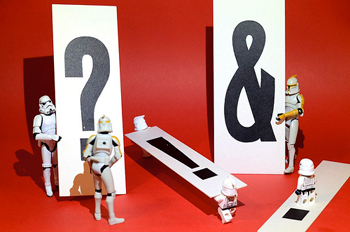
Source: What are you saying?, Kristina Alexanderson, Flickr
Periods, known as terminators, are the most common way to end a sentence. Periods are not the only punctuation marks that can be used at the end of sentences, though. Different types of sentences require different kinds of terminal punctuation, such as the question mark and the exclamation mark. In this section of the lesson, you will review four types of sentences and how to punctuate them.
- A statement is a type of sentence that tells something. Also called a declarative or an assertive sentence, a statement shares information with the reader and usually ends with a period.
My short sentences are just fine.
- A question is a type of sentence that asks something. Also called an interrogative sentence, a question usually begins with who, what, where, when, why, how, or do and ends with a question mark.
Why can’t we all switch to Verdana font? - An exclamation is a type of sentence that shares a strong feeling such as excitement, happiness, anger, or surprise. Also called an exclamatory sentence, an exclamation is punctuated with an exclamation mark. You should use this punctuation mark sparingly.
You have to be kidding me! - A command is a type of sentence that gives a direction or an order to do something. Also called an imperative sentence, a command can be punctuated with a period or an exclamation mark. Imperative sentences, which are useful for giving orders, can often be heard in classrooms. The subject you is understood (i.e., not written or stated) in most imperative sentences.
Take out your notebooks. Put that down now!
Depending on your purpose, the content of a statement can be changed to an exclamation, a question, or a command. In Elements of Style—a famous book about how to be a good writer—author William Strunk writes the following:
Vigorous writing is concise. A sentence should contain no unnecessary words, a paragraph no unnecessary sentences, for the same reason that a drawing should have no unnecessary lines and a machine no unnecessary parts.

Source: Chief Joseph Nez Perce ..., marsmet471, Flickr
The exclamation, question, and command below are inspired by Strunk’s statements.
Exclamatory: A sentence should never contain unnecessary words!
Interrogative: Do you have unnecessary words in your sentences?
Imperative: Don’t put unnecessary words in your sentences.
Declarative sentence: The exclamation point is overused by many inexperienced writers.
Sample Responses:
Exclamatory: Yikes! Surely the writer didn’t use another exclamation mark!
Interrogative: Did you overuse the exclamation mark?
Imperative: Don’t overuse the exclamation mark.
Another kind of punctuation may “sort of” terminate a sentence: the ellipsis, a series of three spaced dots
( . . . ). It sort of terminates a sentence because the ellipsis is generally too weak to stop a sentence.
I looked at their expressions to see if anything had happened,
but I couldn't tell . . .
Let’s read what Grammar Girl has to say about the use of the ellipsis:
You should not replace all normal punctuation with ellipses. You should not allow the sweet lure of ellipses to muddle your ability to write a complete sentence. To quote the book Grammar for Dummies, “Using ellipses in this way can get annoying really fast.” The author of one of my favorite books, Punctuate It Right, feels this way about writers who use ellipses to imply that they have more to say: “It is doubtful that they have anything in mind, and the device seems a rather cheap one.”
So, use ellipses to show hesitation or a trailing off of thoughts if you must, but use them sparingly, and know that although it's grammatically correct, it's considered by some to be annoying and cheap.
See more at: Ellipses
At this stage of the game, you should probably reserve ellipses for your fiction writing; even then, ellipses should be used rarely. You might also have noticed that your computer word processor likes to use three dots without spaces (...). Just because it does, doesn’t mean that it’s correct. You will have to go back and replace each automatically inserted ellipsis with a series of three spaced dots when your word processor acts like it has a mind of its own.

Source: The Picture of Dorian Gray, painting by Ivan Albright, mookiefl, Flickr
Words! Mere words! How terrible they were! How clear, and vivid, and cruel! One could not escape from them. And yet what a subtle magic there was in them! They seemed to be able to give a plastic form to formless things, and to have a music of their own as sweet as that of viol or of lute. Mere words! Was there anything so real as words?
If you wanted to shorten the quotation above to avoid having to explain what a viol or lute is, you’d use an ellipsis. Remember to place a space before, after, and between each of the dots. When placed at the end of a sentence, the ellipsis needs an extra dot: the first dot for the period and three spaced dots after that.
Words! Mere words! How terrible they were! How clear, and vivid, and cruel! One could not escape from them. And yet what a subtle magic there was to them! They seemed
to . . . have a music of their own . . . . Mere words! Was there anything so real as words?
You may have noticed that interjections with exclamation marks were all the rage in the 1890s, when Oscar Wilde reached the height of his popularity. If that trend becomes fashionable again anytime soon, this page will be updated to reflect that change. Until then, let’s not write narratives that invite readers to think, “Interjections! Mere words! How terrible they were! One cannot escape from them.”
Read the casual review of the novel The Picture of Dorian Gray in the box below. Remember, you want to be careful when you decide to use an ellipsis. The sample of student writing below is provided to show you how to use an ellipsis correctly.
My class went on a field trip to the museum. There I saw the strangest painting. It was a painting of a guy named Dorian Gray. He was a character in a famous novel. My teacher told me a little about the story. The guy, Dorian, doesn’t want to get old, so he makes a trade that will allow his portrait to age instead of him. So while Dorian’s portrait ages, he remains young. Lots of other things happen in the book . . . until finally Dorian stabs his portrait of himself as an old man. When that happens, there is a cool ending to the book: “They found hanging upon the wall a splendid portrait of their master as they had last seen him, in all the wonder of his exquisite youth and beauty.” His portrait changed back to the young Dorian Gray! Wild isn’t it?
Maybe you are not in the habit of using the ellipsis, but you have been adding periods to your sentences since elementary school. When you hurry, you can still forget them. To solve this problem, print your work and proofread it for periods and other punctuation. You may see small errors on a hard copy that are easily overlooked on a computer screen. Any punctuation used in threes—with the exception of the ellipsis—should be flagged. Using three exclamation marks (!!!) does not mean you are shouting three times louder. Using three question marks (???) does not make your question three times more mysterious. One terminator per sentence should be enough to help you get your point across.